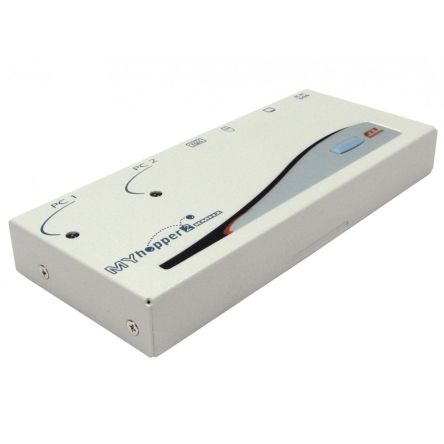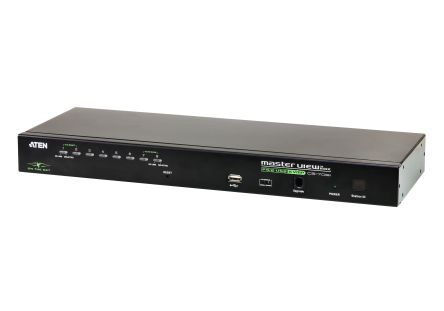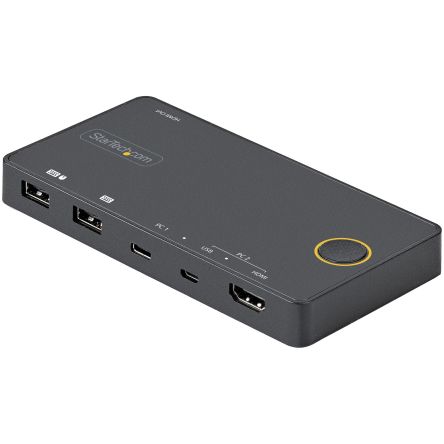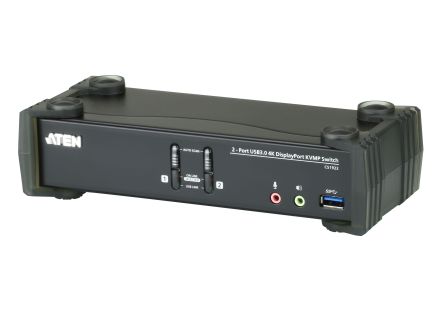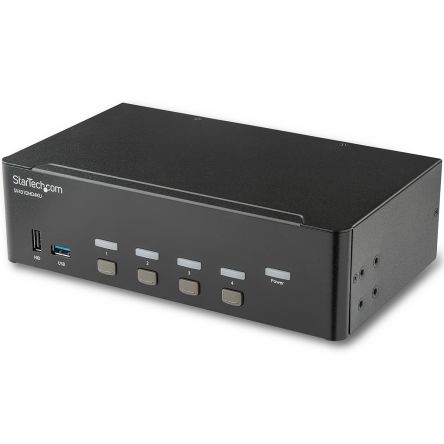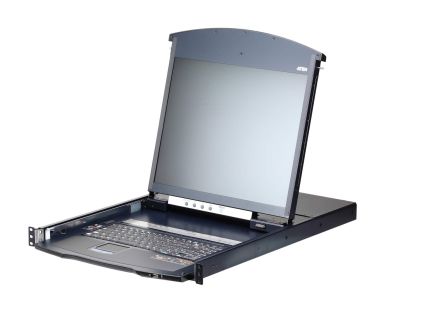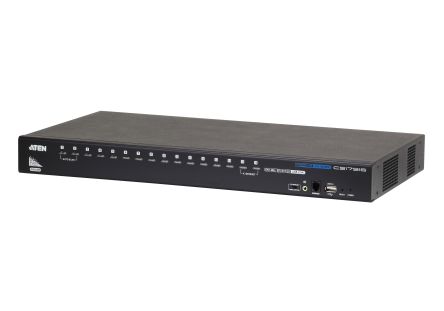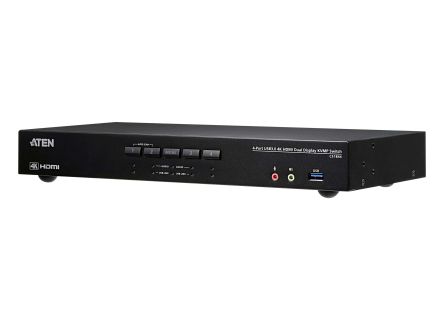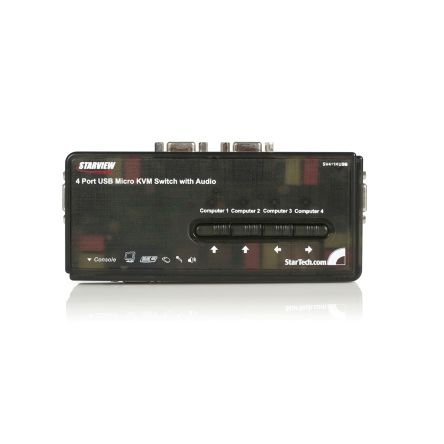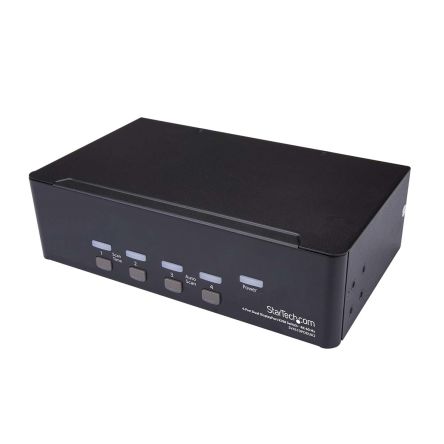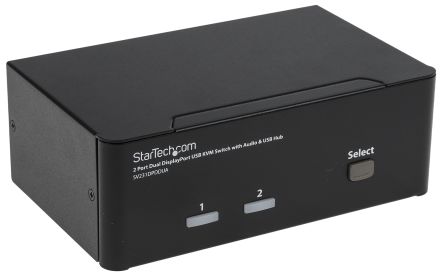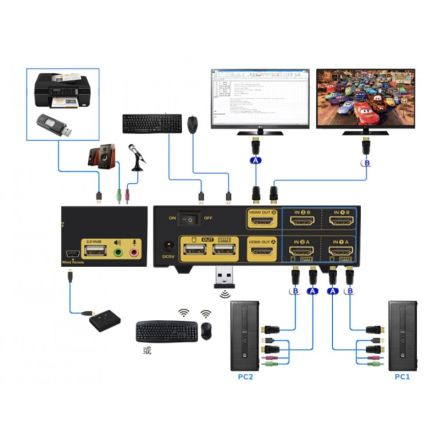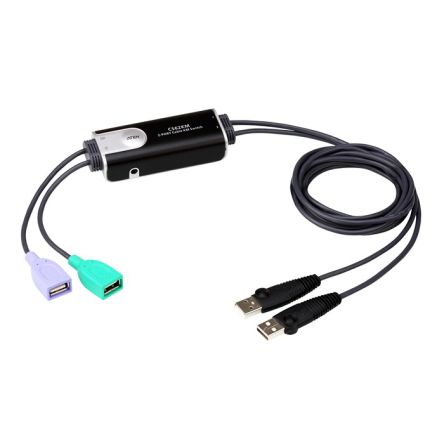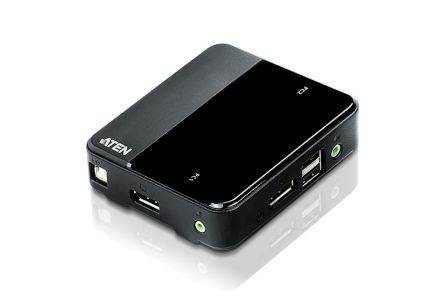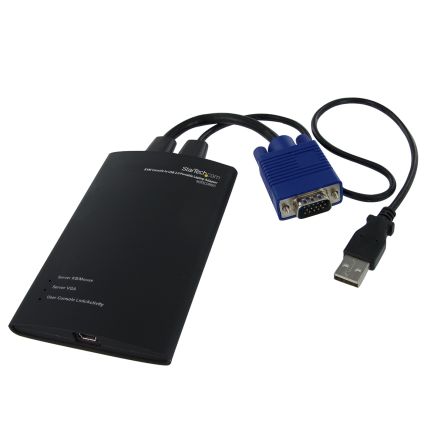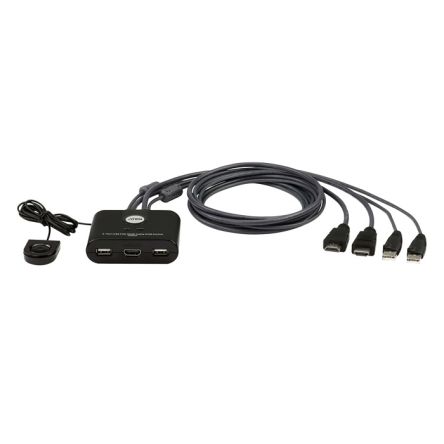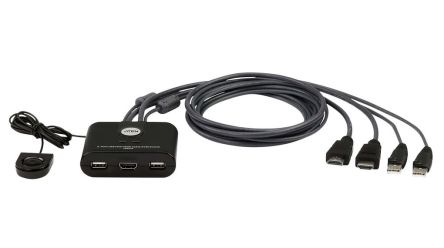- Automation & Control Gear
- Cables & Wires
- Enclosures & Server Racks
- Fuses & Circuit Breakers
- HVAC, Fans & Thermal Management
- Lighting
- Relays & Signal Conditioning
- Switches
- Batteries & Chargers
- Connectors
- Displays & Optoelectronics
- ESD Control, Cleanroom & PCB Prototyping
- Passive Components
- Power Supplies & Transformers
- Raspberry Pi, Arduino, ROCK, STEM Education & Development Tools
- Semiconductors
KVM Switches
A KVM (keyboard, video and mouse) switch or sometimes referred to as a server switch or CPU switch is a hardware device that enables a user or multiple user's reliable access to control a number of computers using a single keyboard, monitor (video display) and mouse. KVM switches are increasingly popular for managing multiple systems efficiently. Some advanced models, known as KVM switch dual monitor setups, even allow for control of multiple computers with dual monitor setups.
How Does a KVM Switch Work?
A KVM switch pushes multiple video and peripheral signals and produces a single output to a single keyboard, video or mouse, allowing for quick access to several computers and data sources.
Some KVM switches allow users to alternate audio and USB devices between computers, and many are designed for connections of up to thousands of users and servers controlled from a single console.
When Are KVM Switches Used?
KVM switches may be used during the following scenarios:
Control Multiple Computers: KVM switches are commonly used in environments when you need to control multiple computers like in a data centre. With a single switch, the administrator can alternate access from one computer to another on a single monitor.
Multi-user Computer Control: by using a KVM Matrix switch, multiple users can control one to many shared computers, enabling cross-functional access to data.
Control of Multiple Operating Systems: KVM switches enable users to switch across multiple operating systems such as Microsoft Windows, Mac, Linux
What Are the Different Types of KVM Switches?
DisplayPort KVM Switch: Becoming increasingly popular as video display manufacturers are moving away from DVI-I and VGA. DisplayPort KVM switches are beneficial for peripheral sharing. There are also dual DisplayPort KVM switches which allow users to share many USB peripherals across all computers.
DVI KVM Switch: Used with DVI compatible monitor(s). These are intended to deliver reliable digital video capabilities, providing better solutions by overcoming resolution limitations of VGA formats. The switches can work with either single or dual link DVI-D or DVI-I and can also offer reverse compatibility. This can be useful for those users who need to work with high-performance workstations.
HDMI KVM Switch: This is an ideal switch for those looking for HDMI signal switching that does not affect video quality. The HDMI KVM switches are known for quick switching without interruptions. They are commonly used in broadcasting, medical imaging, home and commercial theatres and digital signage.
USB KVM Switch: A common type of switch that uses USB cables for keyboard video & mouse connections, some models will also work with PS/2 connectivity and allows for audio sharing and wireless connectivity. Modern USB KVM switches use USB-C, supporting high-speed data transfer and power delivery. These switches are ideal for setups requiring dual monitor configurations, providing seamless connectivity for multiple displays and peripherals.
KVM-over-IP Switch: These types of switches give user's access or monitor multiple PCs and servers in a dedicated network, LAN or even over a WAN from anywhere with IP remote access. KVM/IP Switch are mostly found in medium or large data centres who need multiple users to monitor several computers or servers.
Multi-Display KVM Switch: For users requiring extended desktops across multiple displays, multi-display KVM switches are the perfect solution. They support various video inputs, including VGA, DVI, HDMI, and DisplayPort, and can even accommodate mixed input configurations. These switches cater to setups with dual to four monitors or even more for specialised applications.
Multi-User KVM Switch: These switches enable simultaneous access by multiple users from different locations, achieved through extension, over-IP access, or a combination of both. Multi-user KVM switches are a valuable asset for enterprise applications where cross-platform switching, and collaboration is essential.
Rack Console KVM Switch: Rack consoles are integrated units designed to save space in server racks. These compact solutions combine a display, keyboard, and mouse/touchpad into a convenient pull-out drawer, offering direct access to servers within the rack. Some models even include an integrated KVM switch, allowing control of multiple servers from a single console. However, it's important to consider the compatibility of the mounting rails with your specific server rack when choosing a rack console.
What To Consider When Buying a KVM Switch
- Consider Your Setup: Identify the number of computers, monitors, and additional peripherals (keyboard, mouse, printer, webcam, speakers, microphone) you plan to use. Most KVM switches support 2-4 computers, 1-3 monitors, and 2-4 peripherals.
- Check Computer Ports: Determine the types of ports your computers have (HDMI, VGA, DisplayPort, USB-A, USB-C). Ensure the KVM switch supports the required cables for seamless connectivity, especially matching the KVM’s video output with your monitors.
- Resolution and Refresh Rate: Ensure the KVM switch supports your display's native resolution and refresh rate. Common requirements include 1080p at 60Hz, but for higher resolutions like 4K or 1440p, check for specific support.
Industrial Applications of KVM Switches
KVM (Keyboard, Video, Mouse) switches play a crucial role in various industrial applications, offering efficient control and management of multiple computers or servers from a single workstation. This technology has become indispensable in modern enterprise infrastructure, providing numerous benefits across different sectors.
Data Centers and Server Rooms
In data centres and server rooms, KVM switches allow IT administrators to:
- Control numerous servers from a single console, reducing the need for multiple keyboards, monitors, and mice.
- Quickly switch between systems for maintenance and monitoring.
- Save space in rack-mounted environments by eliminating the need for separate peripherals for each server.
Industrial Control Systems
In manufacturing and process control environments, KVM switches enable operators to:
- Monitor and control multiple production lines or processes from a centralised workstation.
- Switch between different control systems seamlessly, improving response times and efficiency.
- Manage various industrial PCs and PLCs (Programmable Logic Controllers) from a single interface.
Healthcare and Medical Imaging
KVM switches play a vital role in healthcare settings, particularly in:
- Radiology departments, allowing radiologists to use one set of peripherals to view and manipulate images from multiple imaging devices.
- Operating rooms, enabling surgeons and staff to control various medical devices and imaging systems.
- Laboratory environments, enabling the use of multiple analytical instruments and data systems with one set of controls.
Energy and Utility Management
KVM switches are employed in power plants and utility control rooms to:
- Monitor and control various aspects of power generation and distribution.
- Manage SCADA (Supervisory Control and Data Acquisition) systems.
- Facilitate quick response to emergencies by allowing operators to access multiple systems simultaneously.
Buying KVM Switches: Ordering & Delivery
RS is a trusted supplier and distributor of KVM switches from leading brands such Aten, StarTech, Rextron, and more. To place an order online, browse our extensive catalogue where you can filter and select your preferred products based on your specifications.
RS Singapore offers fast delivery of monitoring relays and all sorts of other electronic components. For more details on delivery services and fees, please refer to our Delivery Page.
Explore the new look of the category page
Popular Searches
Related links
- NewLink 2 Port Dual Monitor USB DisplayPort KVM Switch, 3.5 mm...
- StarTech.com 2 Port Dual Monitor USB DisplayPort KVM Switch, 3.5...
- StarTech.com 4 Port Dual Monitor USB DisplayPort KVM Switch, 3.5...
- RS PRO 2 Port Dual Monitor USB HDMI KVM Switch
- StarTech.com 2 Port Dual Monitor USB HDMI KVM Switch, 3.5 mm...
- StarTech.com 4 Port Dual Monitor USB HDMI KVM Switch, 3.5 mm...
- StarTech.com 2 Port Dual Monitor USB HDMI KVM Switch, 3.5 mm...
- NewLink 2 Port Dual Monitor USB HDMI KVM Switch, 3.5 mm Stereo...
